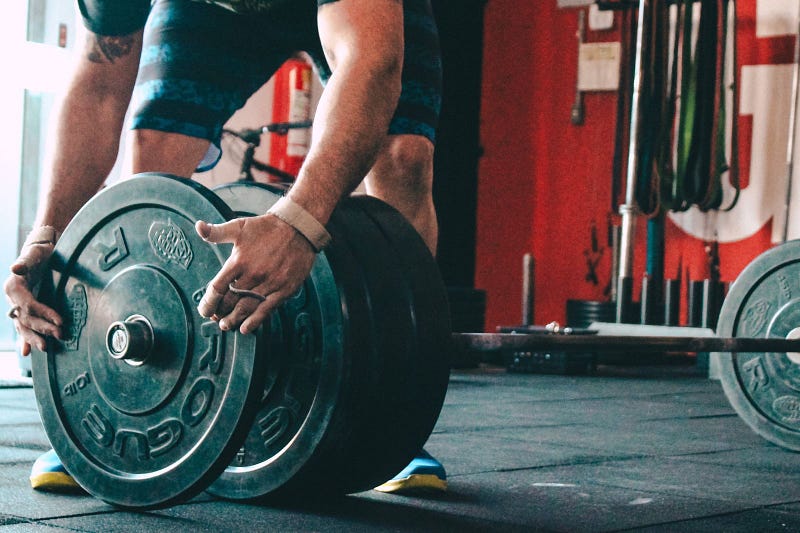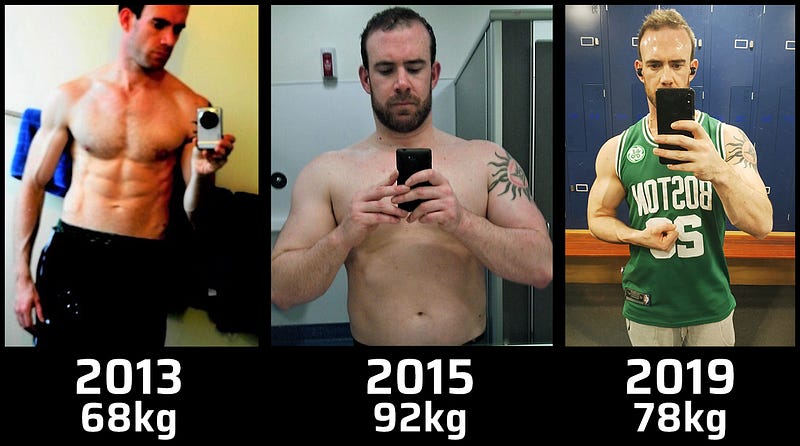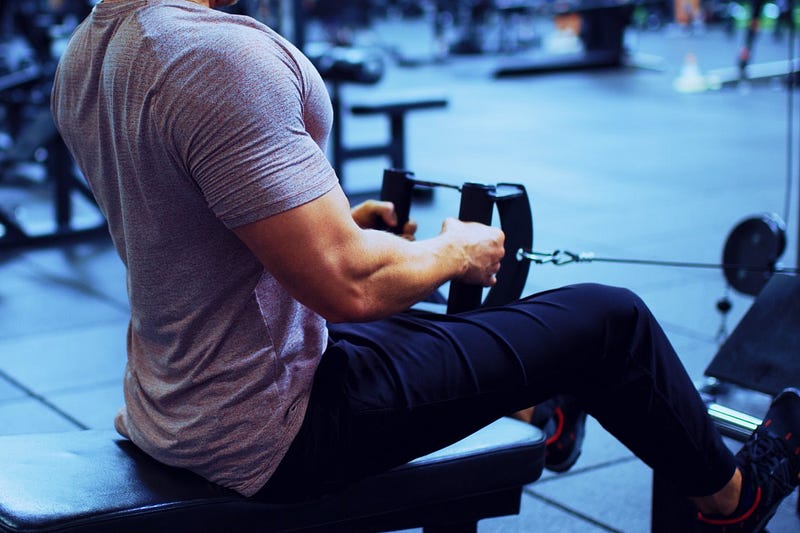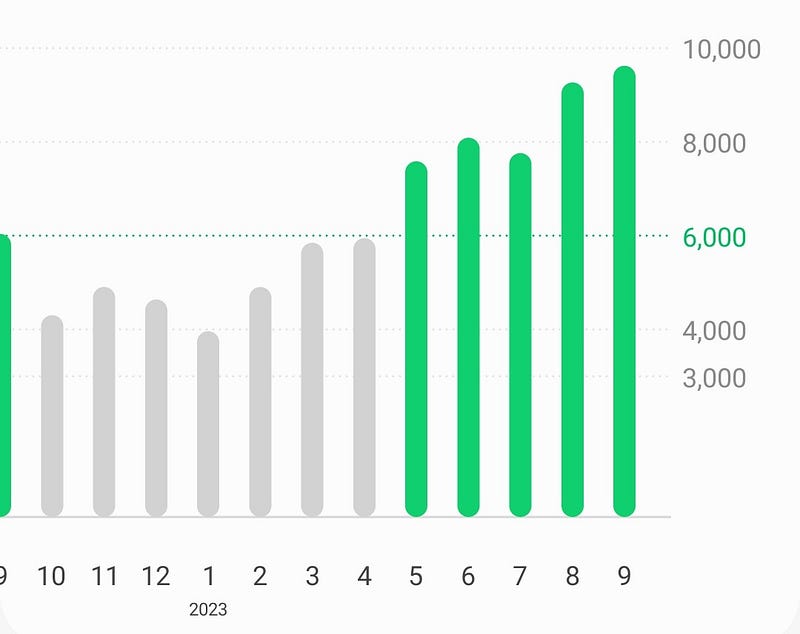A Physique and Training Update
Do I practise what I preach?

I have been writing about health and fitness on Medium for around two and a half years.
If you don’t know me, which you probably won’t — Hi, I am Dan. If you are familiar with my writing, thanks for stopping by again!
I lift weights six days a week, walk a lot, eat pretty healthy but enjoy a good burger, and play the odd game of pick-up basketball on a Sunday.
I am 38 years old, often get told I look much younger and have spent a lot of time researching how to look more “aesthetic” and perform better in the gym and on the pitch (sports reference) long before I started writing.
My profile picture might look unassuming for someone who claims they lift… But I would say I have been a gym rat for well over 15 years now. I’ve built what some would consider an “impressive” physique.
If you want to check out some of my fitness journey, read this article.
Here are some physique shots over the years.

My last personal update on Medium was that I had stopped weighing myself because of the frustration of the slow (planned) progress of my weight reduction on the scale.
Well, duh… right? If slow weight loss is planned, why am I getting frustrated?
We like to see some tangible evidence as reinforcement that we are heading in the right direction. Instead, I decided to trust the process. I have done it before — more than once. I know my body, and I have a deep understanding of nutrition.
Many of my recent blogs have been very science-based, and I haven’t talked much about myself.
This article is a general update on my training and results.
If you are on a fitness journey, good luck! You might get some good tips from reading on.
And no, I still have not weighed myself.
Training Update
Over the past couple of years, I have made a few changes to how I train.
My gym sessions will look very similar to the uneducated eye, just a dude lifting some tin, but I have made some notable changes to how I approach my training.
In short, I have more of a hypertrophic (muscle-building) focus than previously, where strength training was my main priority.
In this section, I will discuss some of these changes.
More reps, less load
I used to often train with heavy loads in the low rep ranges (1–5 reps). Powerlifters primarily train in this way, as it is the most effective way to increase our strength through progressive overload.
The exercises I use for strength training are the squat, deadlift, bench press and overhead press. The weight [load] used on the bar is typically a high percentage of our one-rep maximum [1RM].
The problem with this training method for someone wanting to optimise building muscle is that it is highly fatiguing. This means that for the exercises following this, our intensity reduces. And there is a relationship between training intensity and our ability to stimulate hypertrophy (muscle growth).
Now, very little of my training is in this rep range. I might do one set of heavy squats for 2–5 reps once or twice a fortnight.
Instead, most of my training is in the 8–15 rep range. This rep range provides a middle ground between load/mechanical tension versus fatigue. A lighter weight also makes it easier to establish a mind-muscle connection because we can put it through a full range of motion and really focus on trying to feel a squeeze in the target muscle group and the stretch.
Check out this article for more about the science behind hypertrophy (building muscle).

More machines, less free weights
When I think back to about 5–10 years ago, my mentality around the value of using machines in the gym has certainly changed.
I previously had a big emphasis on functional strength due to playing sports, so I did a lot of free-weight exercises. I often did heavy squats, deadlifts, and power cleans in the same session. You would never see me use gym equipment like a cable-loaded machine shoulder press or a Smith machine.
Now, that has all changed.
As I age, recovery is becoming more crucial. Fatigue is a concept that I have done a fair amount of research on.
I explore the stimulus-to-fatigue ratio in depth in another article — a concept relating to how a particular exercise activates a muscle group and forces an adaption versus how fatiguing that exercise is.
For example, a standing overhead press with a barbell has an overall stimulus on your shoulders of about an 8 or 9. However, its fatigue factor would also be around 8 or 9. You must engage your core and glutes, and all your stabilising muscles work overtime.
Instead, I can use a seated machine like a plate-loaded shoulder press or Smith machine. It probably is still a 9 or even 10 for activating my deltoid (shoulder) muscles (the target muscle group); however, seated exercises do not engage the lower body stabilisation muscles, so far less fatigue is induced — maybe a 3-5, depending on how heavy I go.
Hence, the more machine work I do to replace a barbell, the less fatigue I accumulate. Subsequently, my effort does not decline so much over a workout, I recover for my next session and have less chance of injury. This also means I am more consistent with my training in the long run.
In the past, I have had a few knee and lower back injuries related to heavy squats and deadlifts, so I have learned to train a lot smarter.

Shorter lifting sessions, more cardio
A benefit of less focus on strength training is reducing my time lifting weights.
The more weight we put on the bar, the more fatiguing it becomes. High repetitions are far less fatiguing than low reps because the closer we get to our 1-rep maximum strength, the more toll it takes on our central nervous system. The harder it is to recover from this.
After a set of 3–5 squats at around 80–90% of my one rep maximum, my heart is racing for a good few minutes, taking me five to ten minutes to get back to where I feel like I can do another set at the previous intensity.
On the other hand, after ten reps on the pendulum or hack squat machine, I am ready to go again after a couple of minutes.
Shorter rest periods mean I can fit in more volume (number of sets) in less total gym time. Even when leaving the gym after my weights session and 20–30 minutes of cardio, there are often still people on the weights floor who were there when I arrived.
Which brings me to my next point, cardio. I am doing more walking than usual, which I have prioritised due to being on a “cut”/fat loss phase.
As we all know, our weight increases and decreases as we gain or lose body fat (or muscle). To reduce body fat, we need to be in a caloric deficit. This means consuming fewer calories than it takes to sustain our current body mass.
By increasing the number of calories that I burn, I am decreasing my daily caloric intake. I must further reduce my caloric intake to maintain a caloric deficit as I lose weight. Therefore, I have been slowly increasing my cardio.
You can see this trend in my step count below.

Physique Update
I have dropped three belt sizes in a year or so. The little fat crease on my lower back is almost gone, which is when I know I am nearing my target body fat level.
I have maintained a lot of muscle and even built some in my quads, hamstrings, chest, shoulders and back. My shirts are tighter up top and looser below, whilst my trousers have more room up top but are tighter on the legs.
Besides the incremental changes in the mirror, these are my indicators of positive progress. I have not weighed myself for about a year nor taken any measurements.
Here is a little toilet selfie.

For context, I am around 82–85 kg (180–190 pounds), 180 cm (5 foot 11) tall.
I do not expect overnight results. That would take a significant caloric deficit, which takes a lot more effort, is more stressful, and I will lose some muscle. I do not want to do that.
I am in a minimal caloric deficit, so I am burning body fat but still can build muscle during this fat-loss phase. Yes, it is possible to burn fat and build muscle simultaneously!
Check out this article to learn about using a maingaining strategy for body recomposition.
Final Thoughts
In summary, I am a 38-year-old guy from New Zealand who has spent the last 15 years or so prioritising nutrition and spending a fair bit of time in the gym.
Thousands of hours!
In this article, I have discussed some changes in my exercise routine over the past 12-24 months and given a physique update.
Changes I have made to my training have been doing more reps but using less load, using more machines and less free weights, and having shorter lifting sessions but doing more cardio.
I have found more balance as I age. I cannot smash myself in the gym day in and day out like I used to. Well, I should not anyway…
In ten years, I will be thankful for this decision.
Thank you for reading.
If you enjoyed the content, you might be interested in this article about 5 healthy habits that will help you maintain a lean body for life.
If you would like to read more articles like this one, subscribe to be notified when I publish new content.
